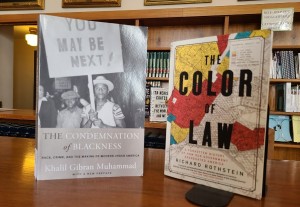The Condemnation of Blackness by Khalil Gibran Muhammad is a scrupulously researched book that documents statistics, “scholarly papers”, and discourse through American history to try and answer the question: How did we come to think of race, and specifically African Americans, as synonymous with crime?
His book examines decades of effort by researchers and social scientists who influenced popular thinking to conclude that the troubles associated with African Americans – poverty, crime, reduced lifespan, were the result of the inherent inferiority of Blacks to their White counterparts. This research became widely accepted because it appeared to be based on neutral and unbiased statistics. However, while the statistics themselves might have been neutral, the specific selection, interpretation, and subsequent conclusions certainly were not. Fredrick Hoffman, one of the first researchers to publish such a biased report linking excessive criminal behavior to Blacks, expressed this idea by stating that crime would increase “until the negro learns to respect life, property, and chastity, until he learns to believe in the value of personal morality in his daily life…”
Hoffman’s book and those by other social scientists pushed the narrative that increased policing was necessary to deal with the “criminal activity” of Blacks. And while these original reports were written more than a century ago, the attitudes and inherent biases that were fostered are still evident today. In 2015, the U.S. Department of Justice investigated the Ferguson Police Department for the killing of Michael Brown. In defending itself, the department claimed that the community problems were not the fault of the police department, but rather “reflect a pervasive lack of ‘personal responsibility’ among ‘certain segments’ of the community.”
Similarly, Richard Rothstein explains in The Color of Law, that local governments, as well as state and federal government agencies used flimsy excuses (that Black families wanted to live in Black neighborhoods, that they couldn’t afford to live in pricier areas, segregation was a way to limit criminal behavior) to create segregated neighborhoods in cities. These methods to create segregated neighborhoods varied. In cities where new construction created new neighborhoods, contractors received subsidies and tax relief for building White-only neighborhoods. Public housing was built to intentionally segregate mixed neighborhoods. Real estate agents worked with cities to redline neighborhoods that restricted who could purchase houses. Banks refused to fund loans to African Americans. And so on. Unfortunately, the result perpetuated a system that actively promoted separation of the races supported at all levels of government.
An area that may be of particular interest to readers is in the very last section of the book. Here, the author answers frequently asked questions about his research and conclusions. Many questions were about his research and the historical context (“Why did leaders whom we consider liberal promote segregationist policies?” and “How can I remove a restrictive covenant from my deed?”), but other questions are more provocative, and unfortunately, very familiar: “Don’t Black people have to take responsibilities for their own lives? Isn’t the real reason why [they] can’t escape the ghetto is that so many are single mothers who can’t or don’t raise their children properly?” His answers to these questions are thoughtful and well-reasoned, and one of the many reasons why you should read this book.
If you are interested in seeing how these restrictive covenants have been applied closer to home, the University of Minnesota project, Mapping Prejudice is an interactive map of Minneapolis that displays properties with racially restrictive language in the property deeds. The time-lapse map shows the gradual increase of properties with restrictive covenants from 1910-1955, and an interactive map allows the user to zoom in on specific lots and see the actual language included on the deed. The project is the first-ever comprehensive visualization of racial covenants for an American city.
Both of these books can be borrowed from the Ramsey County Law Library. Hope to see you soon!
Khalil Gibran Muhammad, The Condemnation of Blackness: Race, crime, and the making of modern urban America, Cambridge: Harvard University Press, 2019.
Richard Rothstein, The Color of Law: A forgotten history of how our government segregated America, New York: Liveright Publishing Corporation, 2017.
